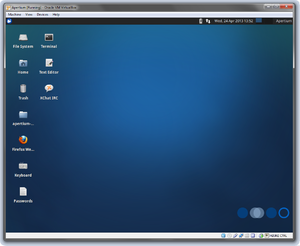Apertium VirtualBox
Since so many have problems getting Apertium to run on Windows or OS X, or are limited in bandwidth, Tino Didriksen has put together a ready-to-use VirtualBox VDI:
- http://tinodidriksen.com/uploads/Apertium-VirtualBox-20160425.7z
- 641157755 bytes (612 MB)
- SHA-1: 3cbb22d6c145c179ac851140493a67bd3afdc3d9
...or if you prefer a ZIP file:
- http://tinodidriksen.com/uploads/Apertium-VirtualBox-20160425.zip
- 1012798465 bytes (966 MB)
- SHA-1: 68b5ab49b2a5ee554b161b276dd0f64499863210
The archive decompresses to a 2.91 GB vdi file.
Important: If you just want to translate, you do not need the VirtualBox image. You can instead use the much smaller Apertium Simpleton UI.
Contents
- Lubuntu 16.04, trimmed of all non-essential packages
- VirtualBox Guest Additions
- XChat, set to automatically connect to Freenode #apertium as nick ap-vbox (appending -2 or -3 on conflict), preconfigured in UTF-8 mode
- Firefox, homepage set to Apertium Wiki
Core tools installed via apt-get from repository http://apertium.projectjj.com/apt/ :
- HFST
- CG-3
- Apertium
- lttoolbox
- apertium-lex-tools
It automatically logs in to a 1024x768 desktop. All passwords set to 'apertium' for when root is needed. Keyboard and timezone are set to Danish, but you can change the keyboard layout from the top right widget.
On first boot, it looks something like:
http://tinodidriksen.com/uploads/Apertium-VirtualBox-20140418.png
On the desktop is apertium-kaz-tat which works - compiling and testing that language pair should pretty much guarantee all required tools are installed and functional.
Nothing else from svn is left checked out - all was wiped after installing in order to save space.
The image is set up as a dynamically expanding hdd with max size 64 GB, where 8 GB is allocated to swap space.
Prerequisites
- VirtualBox from http://virtualbox.org/
- If you downloaded the 7z archive: 7-Zip from http://7-zip.org/ or something else that can decompress 7z files
- Mac OS X: http://kekaosx.com/
- Ubuntu/Debian/Mint:
sudo apt-get install p7zip - CentOS/RHEL/Fedora:
sudo yum install p7zip - Other: http://google.com/search?q=p7zip
Step-by-Step Installation Instructions
1. Download the file (http://tinodidriksen.com/uploads/Apertium-VirtualBox-20160425.7z).
2. Use 7-Zip or a similar program to unzip the file. There should be exactly one thing in the unzipped folder - the Virtual Disk Image (VDI) entitled Apertium (Lubuntu 16.04).
3. Start VirtualBox and click "New" to create a new virtual machine.
4. For the OS Type, select Linux, Ubuntu.
5. For Memory, give it at least 512 MB RAM - it might run with less, but the more the better.
6. For Hard Disk, select the "Use an existing virtual hard drive file" radio button. Pick Apertium (Lubuntu 16.04).vdi from the drop-down menu, or if it isn't there, click the folder icon with the green arrow to the right and navigate to wherever you unzipped the file to. Finish the process by clicking "Create".
7. You can now run the new virtual box. On first boot it should look like this: http://tinodidriksen.com/uploads/Apertium-VirtualBox-20140418.png
Now you should have a system with all the prerequisites installed, and you should be able to follow Minimal installation from SVN to install a language pair (and possibly any required language modules).
Clipboard
To get the clipboard working between the virtualbox and Windows/OS X, go into Options of that VBox -> General -> Advanced tab -> Clipboard -> Bidirectional.
Copying files between Windows and the Virtualbox
You can have Virtualbox mount the Windows drive through VBox's shared folder feature:
- Click "Devices" → "Shared Folders" and find a windows folder you want to share, giving it a name like
Shared. Tick "Make Permanent". - Create a directory in the virtualbox to share it to:
sudo mkdir /media/windows-shared - Mount it like this:
sudo mount -t vboxsf Shared /media/windows-shared - To mount it on each reboot, do
sudo gedit /etc/rc.localand writesudo mount -t vboxsf Shared /media/windows-sharedbefore the "exit" line.
Use
It's easy to install a new language pair on Apertium VirtualBox. The instructions differ for released apertium pairs and unreleased pairs. To get a list of released apertium pairs, run the following in a terminal:
$ apt-cache search apertium- | grep trans
Installing a released pair
To install a released apertium language pair in Apertium VirtualBox, just run the following, substituting "nno-nob" (Nynorsk-Bokmål) with the language pair of your choice.
$ sudo apt-get install apertium-nno-nob
Installing an unreleased pair
Using a language pair
There are several ways you can use a language pair.
1. You can pipe text through it, e.g.
$ echo "this is random text" | apertium nno-nob
2. You can use it in interactive mode, by running it and typing text, e.g.
$ apertium nno-nob this is random text
3. You can use it to translate a file; if you add a second filename, it'll output to that file, e.g.
$ apertium nno-nob infile.txt outfile.txt
4. You can also run a file through it by piping the file's contents through it, e.g.
$ cat file.txt | apertium nno-nob
You can then use the
